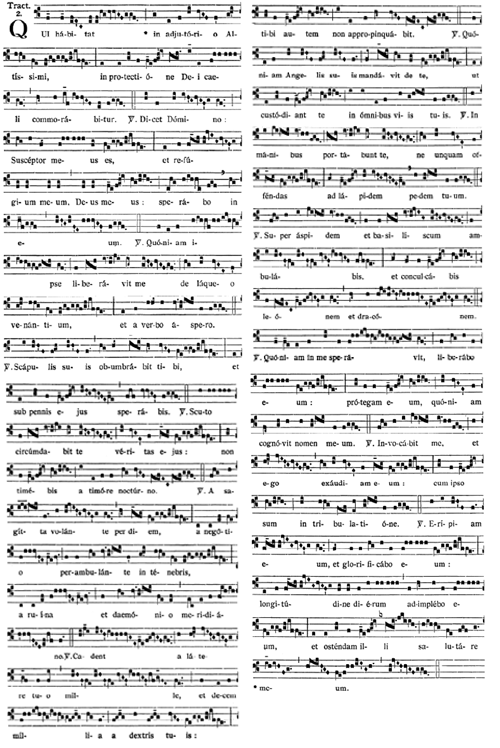How many Catholics know the part of Catholic liturgy called that Tract? Precious few, I suspect. It is the verse that follows the Gradual and precedes the Gospel reading in Lent. The Catholic Encyclopedia calls it a supplement to the Gradual chant. It appears in place of the Alleluia and its verse.
In the ordinary form, it is usually replaced with what is called the “Gospel Acclamation,” but the current practice of singing a short text upsets the balance of form in the Roman Rite. For this reason, even today, the General Instruction of the Roman Missal still recommends the Tract in 62b.
The Tract for this weekend is Qui Habitat from Psalm 91. It is famous for being one of the most extended and elaborate chants in the entire Gregorian repertoire. It lasts as long as eleven minutes. Even celebrants have been known to complain of its length.
One theory about the length I might offer is as follows.
The first Sunday of Lent has an entrance that is exuberant and filled with hope for salvation. Nothing yet occurs aesthetically that might signal the beginning of Lent. But the Gospel changes everything. Jesus goes into the desert. John is arrested. Jesus announces that “this is the time of fulfillment…repent.”
The eleven-minute Psalm occurs just before, as if to remind us that salvation comes at the price of a massive and complex ordeal of suffering: first in the desert in a period of temptation that mirrors our own plight in this vale of tears, and following this, the Son of God slaughtered at the hands of man.
Even if you knew no text and could follow no narrative, and could only hear notes, the signal is presented very profoundly that the time has arrived. As the weeks proceed, the Gospel grows longer, but in this first week, the extended quality of the liturgy in Len—its seriousness of what it requires of Christ and of us—is subsumed in this one chant.
I’m looking now at the Missalette and I see fully two sentences in the “Gospel Acclamation”: Praise to you Lord Jesus Christ, King of Endless Glory. One does not live on bread alone, but on every word that comes forth from the mouth of God.”
Now, compare to the Tract.
I will try to present a miniaturized graphic of it to give you an idea. There are probably whole dissertations written on this, and, if not, there should be. By the way, you can also sing this according to a Psalm tone (AUG or Chants Abreges) or even in English (Abrogast). In fact, this option is very much worth exploring. It seems like any parish could do the tract in English in a Psalm tone, alternating cantor and schola/congregation.


The tract is just used during lent, correct?
I forgot to say. My schola will be singing the tract at a First Friday Mass in April. It will be in English, with a drop-dead-simple psalm tone, as we are still beginning our voyage into chant.
One thing our director (Aristotle Esguerra) pointed out to us is that the "normal" tract (like the one shown above in the post) is actually a glorified psalm tone of sorts.
If you look carefully, these areas look pretty similar, while still unique in their own way.
Qui Habitat… (Line 1)
Deus Meus… (L5)
Non Timebis… (L11-12)
Etc…
Very interesting, I never thought of it that way, but it makes a lot of sense, if you think creatively.
I realize that there is a typo – but it does add a bit of levity to this post, " . . .first in the DESSERT in a period of suffering . . ." this is a new insight I hadn't put together before. 😉